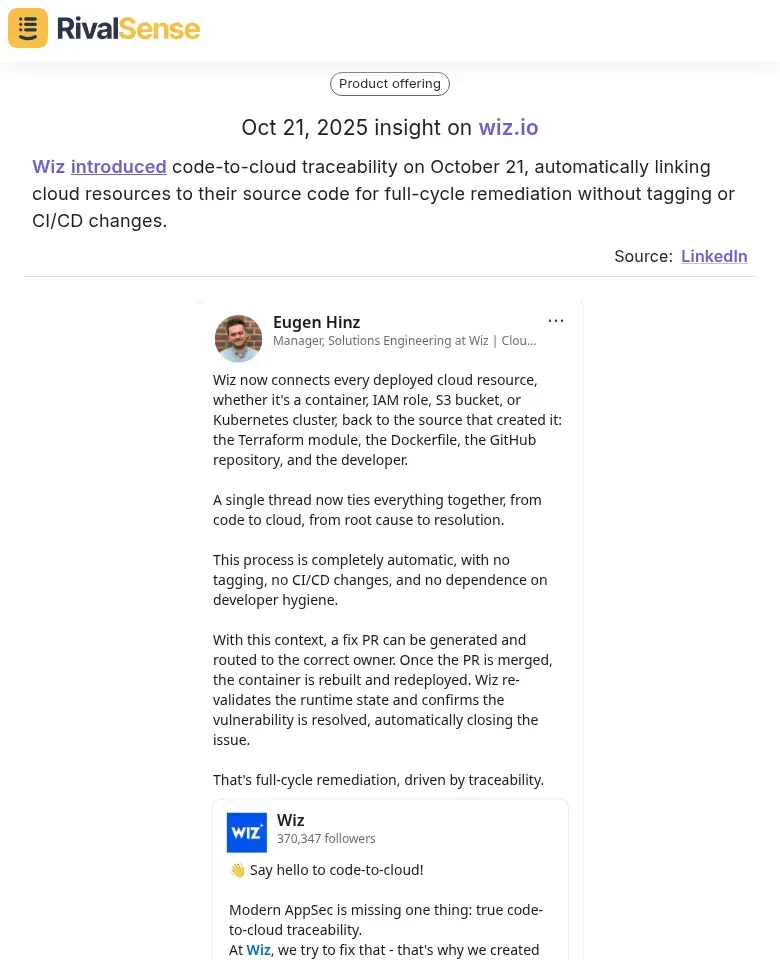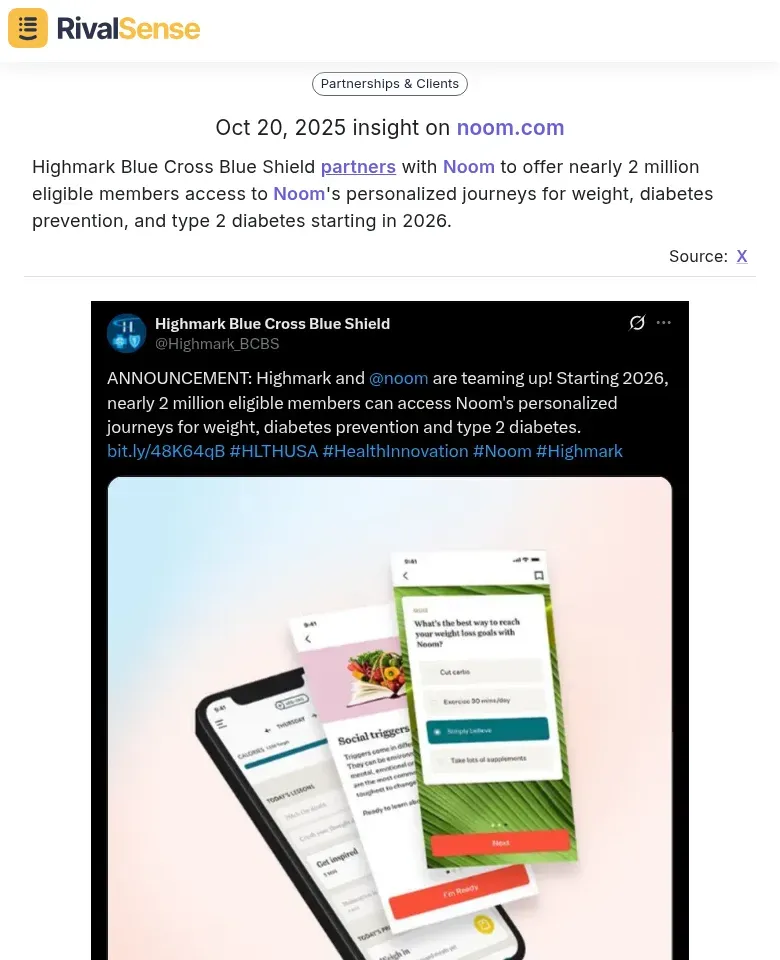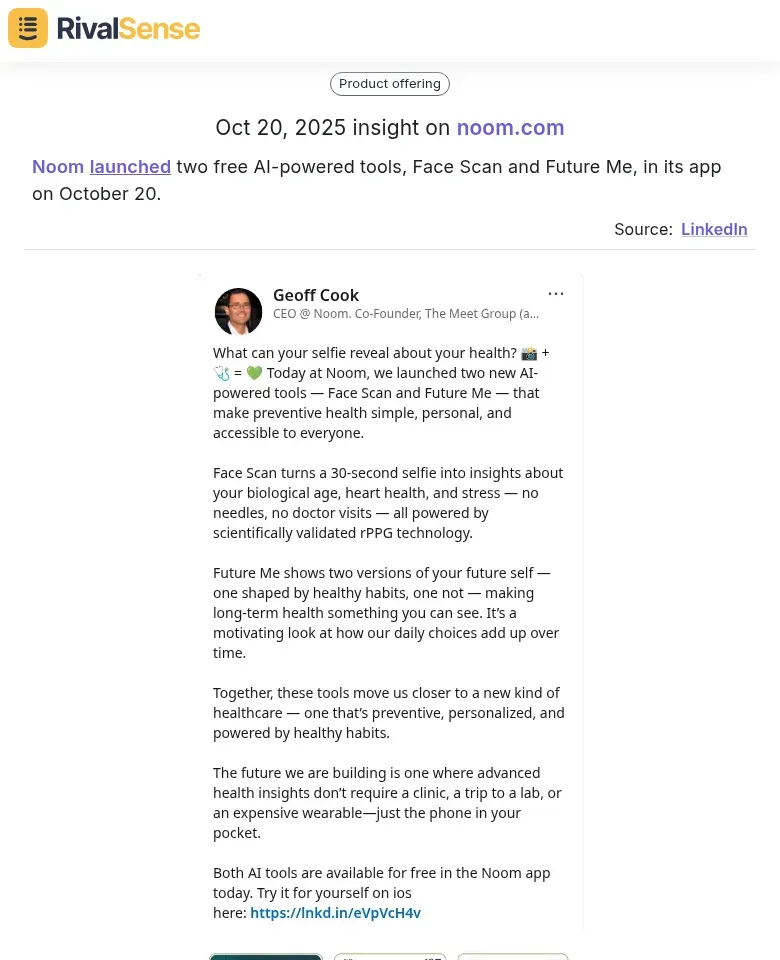Competitive Positioning: The Strategic Advantage That Drives Business Growth
Written by the RivalSense Team
Updated October 21, 2025
In today's crowded marketplace, competitive positioning isn't just a marketing tactic—it's a fundamental business strategy that separates market leaders from the rest. While many companies understand the importance of positioning, few leverage it to its full potential. The difference lies in how you approach competitive intelligence and strategic execution.
What is Competitive Positioning?
Competitive positioning is the strategic process of defining how your brand, product, or service fits within the competitive landscape and how it's perceived by your target audience. It's about carving out a distinct space in the market that highlights your unique value while clearly differentiating you from competitors. Think of it as your business's GPS—it tells you exactly where you stand, where your competitors are positioned, and the most effective route to reach your target customers.
The 4 Ps Framework for Competitive Positioning
To effectively position your business, it's helpful to use a structured framework. The 4 Ps—Product, Price, Place, and Promotion—provide a comprehensive approach to analyzing and defining your competitive stance. This model helps you break down key areas that influence how customers perceive your offering relative to competitors.
1. Product Positioning
Your product positioning should answer: "Why should customers choose us over alternatives?" It focuses on the features, benefits, and unique aspects of your product or service.
Practical Checklist:
- ✅ Map your product features against 3-5 key competitors
- ✅ Identify gaps in competitor offerings that you can fill
- ✅ Document unique selling propositions (USPs) that competitors can't easily replicate
- ✅ Track how competitors are evolving their product lines
Example: A project management tool might position itself as "the most intuitive platform for remote teams" when competitors focus on enterprise features but struggle with user experience.
For instance, RivalSense tracked that Wiz introduced code-to-cloud traceability on October 21, automatically linking cloud resources to their source code for full-cycle remediation without tagging or CI/CD changes. This type of product update insight is valuable because it helps you identify competitor innovations that could shift market expectations and inform your own product roadmap.

2. Price Positioning
Price communicates value and positions you within market segments. It's essential to understand how your pricing compares and what it signals to customers.
Actionable Steps:
- 📊 Monitor competitor pricing changes and promotions
- 📊 Understand the value perception at different price points
- 📊 Identify pricing gaps in the market (premium, mid-range, budget)
- 📊 Test price sensitivity with different customer segments
3. Place Positioning
Where and how customers access your solution matters significantly. This involves distribution channels, partnerships, and geographic reach.
Strategic Considerations:
- 🌐 Analyze competitor distribution channels and partnerships
- 🌐 Identify underserved geographic or digital markets
- 🌐 Evaluate the effectiveness of competitor sales channels
- 🌐 Monitor new market entries by competitors
Monitoring partnerships can reveal new distribution strategies. For example, RivalSense reported that Highmark Blue Cross Blue Shield partners with Noom to offer nearly 2 million eligible members access to Noom's personalized journeys for weight, diabetes prevention, and type 2 diabetes starting in 2026. Tracking such partnerships is crucial for understanding how competitors are expanding their reach and can highlight opportunities for your own channel strategies.

4. Promotion Positioning
How you communicate your value proposition shapes market perception. This includes advertising, content, and public relations efforts.
Monitoring Framework:
- 📢 Track competitor advertising campaigns and messaging
- 📢 Analyze social media engagement and content strategies
- 📢 Monitor event participation and speaking opportunities
- 📢 Document media coverage and PR activities
8 Strategic Benefits of Effective Competitive Positioning
Implementing a strong competitive positioning strategy yields multiple advantages that drive business growth. These benefits not only enhance market presence but also improve operational efficiency and customer loyalty. Here are eight key areas where effective positioning makes a difference.
1. Creates Positive Brand Associations
Strong positioning builds emotional connections with customers. When executed consistently, it creates mental shortcuts that make your brand the obvious choice for specific needs.
Practical Tip: Conduct regular brand perception surveys to ensure your positioning aligns with customer perceptions.
2. Provides Clear Customer Value Proposition
A well-defined position gives customers a compelling reason to choose you. It answers the fundamental question: "What's in it for me?"
Implementation Strategy: Develop a positioning statement that clearly articulates your target audience, market category, unique benefits, and proof points.
3. Optimizes Marketing Spend
Knowing your competitive position helps you allocate resources more effectively. Instead of competing everywhere, you can focus on your strongest differentiators.
Cost-Saving Insight: Companies that track competitor marketing activities can avoid costly battles in oversaturated channels and instead invest in underserved opportunities.
4. Enhances Competitive Intelligence
Positioning requires deep understanding of your competitive landscape. This intelligence becomes a strategic asset for informed decision-making.
Pro Tip: Use automated competitor tracking tools like RivalSense to monitor product launches, pricing changes, and market movements across 80+ sources, delivered in weekly reports that keep your positioning strategy current.
5. Enables Proactive Market Adaptation
Markets evolve, and so should your positioning. Regular competitive analysis helps you spot trends before they become mainstream.
Early Warning System: Track competitor regulatory filings, management changes, and partnership announcements to anticipate market shifts.
Staying updated on competitor product launches allows you to adapt quickly. For example, RivalSense highlighted that Noom launched two free AI-powered tools, Face Scan and Future Me, in its app on October 20. Insights into new tool launches help you anticipate technological trends and adjust your positioning to stay competitive.

6. Deepens Customer Understanding
Effective positioning requires intimate knowledge of customer pain points and desires. This insight drives product development and customer experience improvements.
Customer-Centric Approach: Use competitive gaps to identify unmet customer needs that your business can address.
7. Builds Sustainable Brand Loyalty
When customers consistently experience your unique value proposition, they become advocates who reinforce your market position.
Loyalty Driver: Focus on delivering the specific benefits that differentiate you from competitors, creating memorable customer experiences.
8. Strengthens Team Alignment
A clear positioning strategy gives everyone in your organization a shared understanding of your competitive advantage and strategic direction.
Internal Alignment: Use your positioning statement as a north star for decision-making across departments.
5-Step Framework for Developing Your Competitive Positioning Strategy
Creating an effective competitive positioning strategy requires a methodical approach. This five-step framework guides you through the process from analysis to implementation and refinement, ensuring your positioning is both defensible and dynamic.
Step 1: Conduct Comprehensive Competitor Analysis
This is where most companies fall short. Effective positioning requires ongoing, systematic competitor monitoring to gather actionable insights.
Competitor Tracking Checklist:
- 🔍 Product features and roadmap analysis
- 🔍 Pricing strategy and discount patterns
- 🔍 Marketing and advertising campaigns
- 🔍 Social media presence and engagement
- 🔍 Customer reviews and satisfaction metrics
- 🔍 Partnership and distribution networks
- 🔍 Management team changes and hiring patterns
- 🔍 Regulatory compliance and industry certifications
Practical Insight: Tools like RivalSense automate this process by tracking 80+ data sources and delivering actionable intelligence in weekly reports, saving hundreds of hours in manual research.
Step 2: Craft Your Positioning Statement
Your positioning statement should be specific, defensible, and aligned with market realities. It serves as the foundation for all strategic decisions.
Template: "For [target audience] who [specific need], our [product/service] provides [unique benefit] unlike [primary competitor] because [key differentiator]."
Step 3: Develop Your Brand Tagline
Your tagline should encapsulate your positioning in a memorable phrase that resonates with your audience.
Best Practices:
- 🎯 Keep it short and impactful
- 🎯 Focus on benefits, not features
- 🎯 Ensure it's unique within your competitive set
- 🎯 Test it with your target audience
Step 4: Define Your Unique Value Position
Identify what makes you uniquely valuable to your target market. This differentiation is key to standing out.
Differentiation Framework:
- ⚡ Feature differentiation: What can you do that competitors can't?
- ⚡ Experience differentiation: How is the customer journey better?
- ⚡ Price differentiation: Are you offering better value?
- ⚡ Service differentiation: Do you provide superior support?
Step 5: Test and Refine Your Positioning
Positioning isn't static. Regular testing ensures it remains relevant and effective in a changing market.
Testing Methods:
- 📈 A/B test messaging with different audience segments
- 📈 Monitor conversion rates for different positioning angles
- 📈 Track brand awareness and recall metrics
- 📈 Gather qualitative feedback through customer interviews
The Competitive Intelligence Advantage
What separates successful positioning strategies from mediocre ones is the quality and timeliness of competitive intelligence. Companies that systematically track competitor activities gain several advantages in agility and foresight.
Strategic Benefits of Continuous Monitoring:
- 🚀 Early detection of market shifts and emerging threats
- 🚀 Identification of competitor weaknesses you can exploit
- 🚀 Insights into successful competitor strategies you can adapt
- 🚀 Data-driven decision making for resource allocation
- 🚀 Proactive rather than reactive market positioning
Implementation Tip: Consider using automated competitor intelligence platforms that provide real-time alerts on competitor movements, from product updates to pricing changes and media mentions.
Putting It All Together: Your Competitive Positioning Action Plan
- Week 1-2: Conduct initial competitor audit using the checklist above
- Week 3: Develop your positioning statement and tagline
- Week 4: Implement tracking systems for ongoing competitor monitoring
- Month 2: Test your positioning with target customers
- Ongoing: Review and adjust positioning based on market changes
The Bottom Line
Competitive positioning isn't a one-time exercise—it's an ongoing strategic discipline. The companies that consistently win in their markets are those that maintain superior competitive intelligence and adapt their positioning as market conditions evolve. By implementing a systematic approach to competitor tracking and positioning refinement, you can ensure your business maintains its competitive edge and continues to grow market share.
Ready to take your competitive positioning to the next level? Try RivalSense for free today and get your first competitor report to start gaining actionable insights into your market landscape. Sign up now
📚 Read more
👉 Competitor Promotional Offers Tracking Framework for Influencer Platforms
👉 How Slack's AI Shift Revealed Rivals' Strategic Response
👉 Twitter Competitor Pricing Insights: 2025 Strategic Benchmarking
👉 Media Industry Key Account Tracking: Your Strategic Cheat Sheet
👉 Actionable Market Entry Strategies Using Competitor Insights
